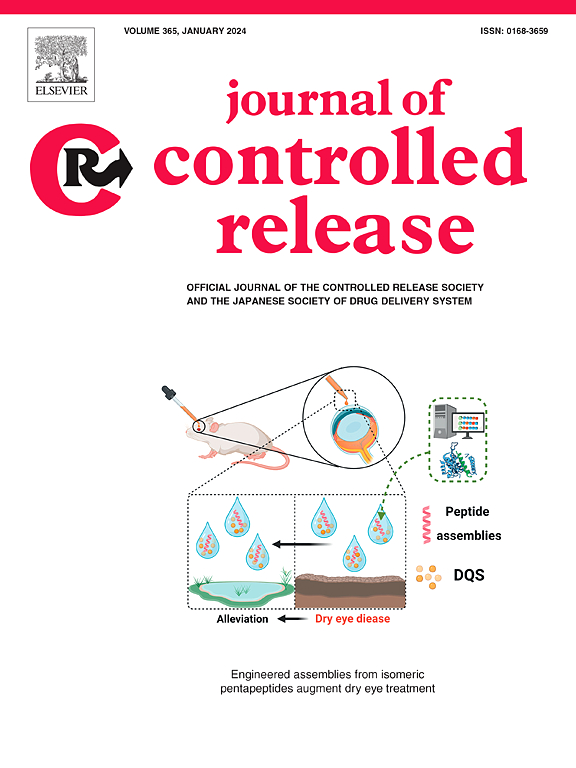在体外、体内和机器学习的辅助下,优化用于胎儿基因递送的脂质纳米颗粒。
IF 10.5
1区 医学
Q1 CHEMISTRY, MULTIDISCIPLINARY
引用次数: 0
摘要
临床上需要开发脂质纳米粒子(LNPs),以便在怀孕期间为胎儿提供先天性疗法。这些疗法的目的是恢复胎儿的正常发育,防止出生后出现不可逆转的情况。作为第一步,LNPs 需要在经胎盘运输、对胎盘屏障和胎儿器官的安全性以及转染效率方面进行优化。我们开发了一个不同成分的 LNPs 库并对其进行了表征,同时使用机器学习(ML)模型来确定 LNP 尺寸和 zeta 电位的决定因素。在随机森林算法的帮助下,我们利用不同的体外胎盘模型,从 41 种 LNP 配方和 48 种不同转运实验所代表的 18 种输入特征中,找出了驱动 24 小时内 LNP 转运和动力学百分比的首要特征。我们进一步评估了 LNP 的安全性、胎盘细胞摄取率、胎盘滋养细胞和胎肺成纤维细胞的转染效率。为确保 LNPs 经胎盘转运后的完整性,我们使用高通量转运-转染综合体外模型对 LNPs 的转运和转染进行了筛选。最后,我们在气管闭塞胎肺移植模型中评估了 LNPs 的毒性。LNPs 对胎儿和胎盘细胞几乎没有毒性。LNPs表面的免疫球蛋白G(IgG)取向、PEG化脂类和可电离脂类对胎盘转运有显著影响。随机森林算法确定了驱动 LNPs 胎盘转运百分比和动力学的首要特征。Zeta电位是最主要的驱动特征。根据 ML 模型的结果,我们开发了新的 LNP 配方,进一步优化了转运,使 24 小时后的转运率与对照 LNP 配方相比提高了 622%。为了诱导 siRNA 优先转染胎肺,我们进一步优化了阳离子脂质的比例和脂质与 siRNA 的比例。在胎盘和胎肺成纤维细胞综合模型中对 LNPs 的研究表明,zeta 电位与胎肺转染之间存在很强的相关性。最后,我们在气管闭塞肺移植模型中评估了 LNPs 的毒性。凋亡(Caspase-3)和增殖(Ki67)标志物的微小变化表明,优化后的制剂似乎对体内胎肺是安全的。总之,我们优化了一种 LNP 配方,这种配方安全、经胎盘转运率高,并能优先转染胎儿肺细胞。我们的研究成果标志着我们在确定 LNPs 用于胎儿器官基因递送的安全性和有效性方面迈出了重要一步。本文章由计算机程序翻译,如有差异,请以英文原文为准。

Optimizing lipid nanoparticles for fetal gene delivery in vitro, ex vivo, and aided with machine learning
There is a clinical need to develop lipid nanoparticles (LNPs) to deliver congenital therapies to the fetus during pregnancy. The aim of these therapies is to restore normal fetal development and prevent irreversible conditions after birth. As a first step, LNPs need to be optimized for transplacental transport, safety on the placental barrier and fetal organs and transfection efficiency. We developed and characterized a library of LNPs of varying compositions and used machine learning (ML) models to delineate the determinants of LNP size and zeta potential. Utilizing different in vitro placental models with the help of a Random Forest algorithm, we could identify the top features driving percentage LNP transport and kinetics at 24 h, out of a total of 18 input features represented by 41 LNP formulations and 48 different transport experiments. We further evaluated the LNPs for safety, placental cell uptake, transfection efficiency in placental trophoblasts and fetal lung fibroblasts. To ensure the integrity of the LNPs following transplacental transport, we screened LNPs for transport and transfection using a high-throughput integrated transport-transfection in vitro model. Finally, we assessed toxicity of the LNPs in a tracheal occlusion fetal lung explant model. LNPs showed little to no toxicity to fetal and placental cells. Immunoglobin G (IgG) orientation on the surface of LNPs, PEGylated lipids, and ionizable lipids had significant effects on placental transport. The Random Forest algorithm identified the top features driving LNPs placental transport percentage and kinetics. Zeta potential emerged in the top driving features. Building on the ML model results, we developed new LNP formulations to further optimize the transport leading to 622 % increase in transport at 24 h versus control LNP formulation. To induce preferential siRNA transfection of fetal lung, we further optimized cationic lipid percentage and the lipid-to-siRNA ratio. Studying LNPs in an integrated placental and fetal lung fibroblasts model showed a strong correlation between zeta potential and fetal lung transfection. Finally, we assessed the toxicity of LNPs in a tracheal occlusion lung explant model. The optimized formulations appeared to be safe on ex vivo fetal lungs as indicated by insignificant changes in apoptosis (Caspase-3) and proliferation (Ki67) markers. In conclusion, we have optimized an LNP formulation that is safe, with high transplacental transport and preferential transfection in fetal lung cells. Our research findings represent an important step toward establishing the safety and effectiveness of LNPs for gene delivery to the fetal organs.
求助全文
通过发布文献求助,成功后即可免费获取论文全文。
去求助
来源期刊

Journal of Controlled Release
医学-化学综合
CiteScore
18.50
自引率
5.60%
发文量
700
审稿时长
39 days
期刊介绍:
The Journal of Controlled Release (JCR) proudly serves as the Official Journal of the Controlled Release Society and the Japan Society of Drug Delivery System.
Dedicated to the broad field of delivery science and technology, JCR publishes high-quality research articles covering drug delivery systems and all facets of formulations. This includes the physicochemical and biological properties of drugs, design and characterization of dosage forms, release mechanisms, in vivo testing, and formulation research and development across pharmaceutical, diagnostic, agricultural, environmental, cosmetic, and food industries.
Priority is given to manuscripts that contribute to the fundamental understanding of principles or demonstrate the advantages of novel technologies in terms of safety and efficacy over current clinical standards. JCR strives to be a leading platform for advancements in delivery science and technology.
 求助内容:
求助内容: 应助结果提醒方式:
应助结果提醒方式:


